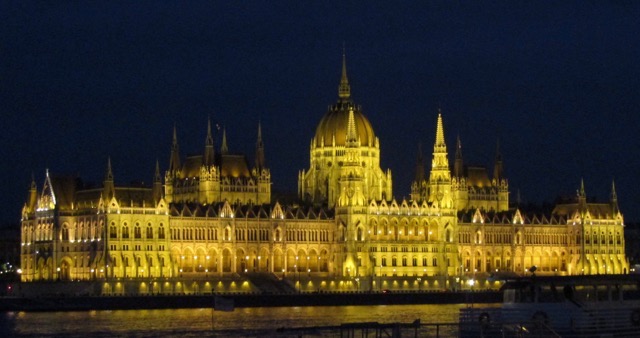Intro: Budapest is a ‘miracle’ city of world class cultural venues, orderly, efficient transportation, reliable peaceful (right-wing) governance, manicured parks, breezy free-thinking cafes, gourmet restaurants, palatial hotels, heroic monuments and palatial thermal baths. The miracle is that the freedom, independence, capitalism, and beauty of today have survived and grown far beyond the chaos and centuries of war, persecution, invasion, holocaust, fascism and communism to become a world-class metropolis. Included in that freedom is a LGBT scene that is mostly alive and well.
Gay Hungary News & Reports 1999 to present
Hungary Photo Galleries
By Richard Ammon
November 2006
Updated April 2016
Gay Budapest: Háttér Society
Along with the great art, great food and great cafes, and I also paid a visit to the humble and anonymous offices of Háttér LGBT association which, like the struggle of David vs Goliath, is still powering along since 1995 advocating for LGBT rights and equality in a generally homophobic country. Hatter has offices but there is no LGBT social center in the city.
The Háttér offices are not easy to find: on the fourth floor of an unappealing apartment building tucked among private and commercial shops and offices, near the dominating church of St Margaret of the Arpad with it imposing dual steeples. A few blocks away is the huge yellow-brick Victorian-style Budapest-Nyugati Railway Terminal whose tracks reach out from Hungary to all of Europe.
As with my first visit several years ago the office is still a busy place. I had to wait 15 minutes to see Tamas Dombos (left in photo below), the director of Háttér, since he was in a meeting with staff planning strategy. As I looked around I saw that the space and condition of the place had not changed much. In 2007 I wrote: “The office was filled with bookcases, files, boxes of brochures Hatter publications, computer desks and a large table in the middle encircling a vase of yellow flowers.” The flowers are gone but the five-room office was a hive of activity with the various programs it runs, from personal to political, from government to educational and healthcare outreach.
Combating homophobia at every level, personal and public, internal and external, family and professional in Hungary is a constant uphill effort. Háttér outreaches to civil and elected organizations (police, fire, hospitals, universities, politicians, some religious denominations); all are essential targets of attention for Háttér, not to mention their crucial telephone hotline service that’s open every day.
Tamas has been with Háttér for eight years. There are eight paid staff and about eighty volunteers who keep Háttér’s services activ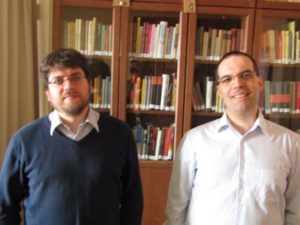 e. Tamas used to work as a researcher in academia, at Central European University, where he also worked on LGBTQI issues. He started to volunteer for Háttér in 2007, got more and more involved, first to work on projects, and then to be full time employed. He was elected as one of the three board members in 2014.
e. Tamas used to work as a researcher in academia, at Central European University, where he also worked on LGBTQI issues. He started to volunteer for Háttér in 2007, got more and more involved, first to work on projects, and then to be full time employed. He was elected as one of the three board members in 2014.
He is surrounded by challenges, especially since a center-right government was elected in 2010; now Háttér must advocate against a conservative attitude toward LGBT citizens. For example, Tamas, said that some Hungarian adolescent students are now being taught that homosexuality is a mental disorder linked to HIV/AIDS, venereal disease, and unhealthy behavior (i.e. sinful; not said explicitly but implied). In protest Tomas has said publicly, “this is biology, not religious education; but this is what you get in supposedly core scientific subjects in the books that the current government recommends for schools.” Hatter works to combat such distortion by meeting with education and government leaders to open their eyes to the overt and covert prejudice in their decisions. It is an endless struggle.
At Háttér offices I also met Sandor Nagy (right in photo)) who, among his other responsibilities, is in charge of the extensive archive at Háttér which currently contains over 1500 books, periodicals, pressing clippings, posters and A-V materials (over 700 films and documentaries) covering the past 20 years of of Hungarian LGBT history. Each item is carefully catalogued and sorted. The archive is supported by private donations as well as supportive organizations such as the Open Society Institute. No funds come from the Hungarian government. The archive also operates the Háttér News service, an internet service that provides daily LGBTI news and reports from around the world.
Since 2011 the archive has participated in the OpenUp project that is affiliated with IHLIA Homodok, an international archive and documentation center on sexual diversity based in Amsterdam which collects and preserves many kinds of information about LGBT life around the world. IHLIA curates the largest LGBT collection in Europe of books, journals and magazines, films, documentaries, posters, photographs and objects such as T-shirts, buttons and condom packaging. IHLIA was founded in 1999 by merging the Homodok (documentation on homosexuality of the University of Amsterdam) and the Lesbian Archives of Amsterdam and Leeuwarden. Since 2007, IHLIA has been located in the Amsterdam Public Library.
Indeed there are numerous services as Háttér has grown over the years. The crucial phone hotline offers free counseling and referrals to inquiring callers. It is one of the most essential services that Hatter has to offer since “nearly every second Hungarian agrees with the statement that homosexuality is a sickness, and would rather not have a gay or lesbian neighbor” said Tomas. As a result, troubled LGBT folks call in seeking support and kindness in their search for identity and safety. Volunteers are trained to offer sympathy as well as referrals to support groups, LGBT clubs and helping agencies. Personal counseling is available from professionals. When necessary they offer free legal aid to victims of discrimination through Háttér’s Gay Legal Aid Services.
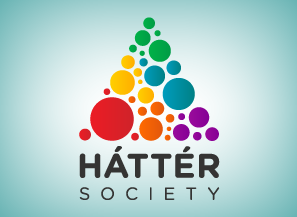 One of Háttér’s most important efforts is running an outreach information and educational program to inform LGBT citizens of their basic human rights that exist in Hungarian law. The vast majority of queer Hungarians are not aware of these and often do not report incidents of discrimination.
One of Háttér’s most important efforts is running an outreach information and educational program to inform LGBT citizens of their basic human rights that exist in Hungarian law. The vast majority of queer Hungarians are not aware of these and often do not report incidents of discrimination.
Another significant challenge for Háttér are HIV/AIDS prevention and education programs. This work is supported by the government health ministry and Háttér’ has succeeded. among other things, in having condom machines installed in the restrooms of gay bars and clubs. Their HIV prevention work is also supported by The Medical College of Wisconsin in Milwaukee in the USA. Brochures and health advisories are constantly flowing from the Háttér’ offices to all LGBT venues and to the public via the press.
Háttér was started in 1995 following the demise of socialism in Hungary. Given Hungary’s awareness of and relative proximity to such gay hotspots as Berlin, Vienna, Zurich and Amsterdam, it didn’t take long for the queer east to raise its voice against three generations of repression and to organize for rights and equality. Non-governmental organizations were not permitted in Hungary before the changing of the political system in 1989. But homophobia did not disappear with the fall of communism: As late as 2010 gay men cruising in parks were entrapped and registered by the police, which is against European human rights standards.
Homophobia in Hungary is not significantly less or more than in most eastern European countries where for most of the 20th century there was little respect for human rights. Anti-gay feelings here are not as politically powerful as in Warsaw where conservatives managed to get Pride parades cancelled in the early 2000s. (That is changing in the twenty teens.) Nor is it as dangerous as in Serbian where mobs of skinheads and neo-Nazi types violently assault gays (and police) during Pride festivals in Belgrade. More recently, Russia has led the way backward to ignorance and discrimination against LGBT citizens with pernicious anti-gay legislation at the national level.
Since my previous visit, one of Háttér’s greatest successes has been to promote and achieve domestic partnerships that are now legally registered, so a couple does not have to prove their alliance each time proof is required. This way they have a document that states their bond. Registered partnerships offer couples similar rights to those of married heterosexual couples such as hospital visitation and access to medical information, the right to make decisions about a deceased partner’s funeral, receiving widow’s pension (after ten years together) and immigration rights (bringing a registered foreign partner into Hungary from abroad). No additional administration is needed to prove the partnership, except the residence card (lakcimkartya) showing the same address for both partners.
However the possibility of marriage is not current. Tamas said, “Since 2010, Hungary has a conservative government that significantly cut back on the rights of LGBTQI people. In 2011, they adopted a new Constitution that defines marriage as a union between a woman and a man and limits the notion of family to spouses and parent-child relationships.”
Háttér’ was also instrumental in the founding of the Hungarian LGBT Alliance in 2011 (Magyar LMBT Szövetség) as an officially registered umbrella organization for LGBTI organizations in Hungary. The Alliance is composed of all LGBT informal groups and registered organizations in the country that advocate or manage LGBT public events, such as Gay Pride Festival as well as the lesbian LIFT festival (Lesbian Identities Festival (www.labrisz.hu).
Professor of Gender Studies Hadley Renkin of Central Europe University (Hungary) has spoken and written about the role and situation of LGBT citizens in Hungary and the need to be organized against oppositional forces. The LGBT Alliance serves as a visible and vocal public organ against discrimination as well as a cohesive force to bring groups together for advocacy as well as celebration.
Digression: Eastern European Gay Life
There are numerous eastern European countries which have sprouted LGBT organizations for political and social purposes since 1989. Although daring, these seem less influential than their western European counterparts.
Much of that difference has to do with money. Even volunteer organizations require money for salaries, office space, advertising, equipment, publications, hosting a conference and postage. Eastern Europe is a poorer sibling to the West. Salaries in Hungary for example are a third to a fourth of what they are in Germany.
One glaring example of this can be seen in the large, well lighted, colorful and visible Man-o-Meter LGBT Center in Berlin (adjacent to the huge Bruno LGBT department store). Mann-o-Meter sponsors dozens of meetings, seminars, educational outreach programs, social events, support groups, legal and medical referrals as well as providing hundreds of free brochures, pamphlets, flyers and magazines with endless listings of LGBT services and events.
Budapest has no gay center, only a dream of one in the minds of activist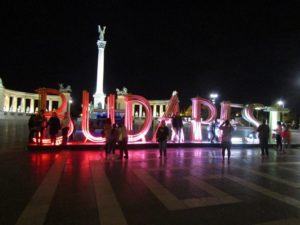 s. Most LGBT Hungarians don’t think much about having such a visible and public center, preferring instead to organize for social and sport activities informally
s. Most LGBT Hungarians don’t think much about having such a visible and public center, preferring instead to organize for social and sport activities informally
Another Háttér staff volunteer told me,”we have several rounds of project writing and applications to the EU. We have also asked overseas funders that work in this region with some results. As for raising community funds from people in Hungary that is not at all easy. We can’t just go and tell (gay) people how wonderful their lives will be if they give us a certain amount of their salaries for this purpose. Private donations sometimes do come but most people think their 1% tax donation should be sufficient.”
This mention of 1% refers to a voluntary income tax donation of 1% that people can designate to a particular charity or a registered organization. It is donated through the government (who have no say in a person’s choice) and provides Háttér’ with some funds but not enough to meet its expenses. Most people think this tax donation is enough charity including LGBT supporters who do not give any more money to help Háttér’ or to help create a LGBT Center.
A second reason for the weaker eastern Europe activist effort has to do with individual ‘potency’. In my previous visit to Háttér’, I had a lengthy talk with Bence Solymar, the director of Háttér’ at the time. She talked about “existential insecurity” for herself and other LGBT citizens, referring to personal confidence that one voice can be heard and can make a difference against discrimination. “It is a fundamental decision for anyone doing LGBT advocacy work. Can I make a difference at this time?” Politics and religion are mighty forces against free expression of sexual rights and equality.
With the advent of the EU in eastern Europe (in May 2004 that included Hungary and eight other countries) new laws and charters regarding politics, economics and human rights arrived as well. The major thrust has been for stronger economic stability in the EU and the LGBT population has also felt residual progressive benefits and seen a better opportunity for gay rights and expression. It has given activists a needed boost of confidence.
Bence continued, “The European Council in Lisbon (1999) realized there must be funds for ‘social inclusion’ because if certain social groups (gypsies, migrants, manual workers, religious and sexual minorities, etc.) continue to be devalued there will be a less motivated work force to maintain this huge EU, and in turn there will be a reduced market if people can’t get work.” So the Council of Europe must promote human rights but still in the service of economic assurance.
As much as this windfall (joining the EU) has created a fertile field for activism, to be productive a field must be plowed, seeded and fertilized if it is to nurture the needs of people. The EU declarations and standards are well intended but the great challenge is to communicate these rights to populations that are generally unaware (or disregard) of them. Respect for individuals and their personal rights was not one of socialism’s better virtues.
 Anti-discrimination has become an important issue in the abstract, but getting local precinct police chiefs (in and beyond Budapest) to train their troops about their duty to seriously respect complaints by gay people is quite another. “A crucial aspect of human rights is enforcing these rights. Police training and awareness and respect for gay rights, taking complaints seriously and apprehending perpetrators, is vital at the local level if change is to come about. We now have an education project with the police and we work to bring about change in the everyday street as well as in the legislation,” Tomas explained.
Anti-discrimination has become an important issue in the abstract, but getting local precinct police chiefs (in and beyond Budapest) to train their troops about their duty to seriously respect complaints by gay people is quite another. “A crucial aspect of human rights is enforcing these rights. Police training and awareness and respect for gay rights, taking complaints seriously and apprehending perpetrators, is vital at the local level if change is to come about. We now have an education project with the police and we work to bring about change in the everyday street as well as in the legislation,” Tomas explained.
Throughout all of Europe—east and west–the results of these efforts have varied greatly. In Sweden, for example, a church minister was given jail time for his caustic criticism of gays when offended individuals took the cleric to court. For many (communist) years the Catholic church and the Reformed church (Lutheran and Calvinists) became accustomed to quasi-official state sanctions and kept their noses out of politics. Although less respected and attended now, church institutions still retain symbolic power and the idea of a homophobic priest or minister in Hungary being taken to court for his homophobia is highly unlikely. Openly LGBT applicants for ministry or priesthood studies are rejected and queer students already in their programs are sometimes expelled.
Case law in eastern Europe–actual tried court cases–regarding sexual orientation discrimination is rare. If a person is attacked or slandered or ejected from a flat or a job few have the financial resources (an average teacher’s salary is about $900 a month) to pay for lawyers’ fees. As well, they do not want to risk the publicity that might put his or her job in jeopardy or risk family rejection as well. Fortunately, Habeas Corpus Association, from Háttér’, do provide some funds for legal recourse, if a person is brave enough to pursue legal action.
A ground-breaking case in Hungary occurred in 2004 when a student was dismissed from a church-owned university in Budapest because he was gay. His father took the university to court and won, but not on principle of fairness and equality but rather on a legal technicality. It was a win but not really a victory for gay rights. The student was readmitted but declined to continue at that university instead chose to go to another (church) school in the Czech Republic.
But most of the time, at the individual level, discriminatory offenses go unreported because there persists a strong sense that it won’t be taken seriously by the authorities. Former director Bence said such existential insecurity exists among Hungarian gays that keeps them from coordinating a more focused community and demanding their rights.
A second significant case worked its way through the legal system. Háttér decided to challenge the anti-gay discrimination policies of a Reformed University because it forbids homosexuals from being admitted or becoming teachers or researchers–as opposed to becoming ministers over which a religious institution has the right to discriminate. Háttér recognized this but sued to have the wider application of these (secular) policies declared unconstitutional and against European Council regulations. The first court ruling was in favor of the University so Háttér took it to the appeals level (the EU court) for consideration because it was important to pursue the anti-human rights issue and make university and legal institutions more aware and accountable for such blatant discrimination. Háttér took it all the way to the the European Court of Justice in the Hague and won; the Court ruled that religious beliefs cannot justify discrimination against same-sex citizens.
Water Babes
Budapest is famous for its many watering holes where people take off their clothes to reveal their various corporeal shapes and sink into thermal baths. There are about a dozen Turkish baths with blue pools that have been an integral part of Budapest for 400 years thanks to the Ottoman Turks and to the naturally occurring hot springs underneath Budapest. As a result there is no dearth of places for a gay person to ‘look around’, overtly or covertl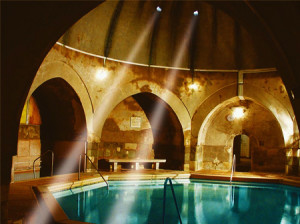 y, in this huge city.
y, in this huge city.
Previously, when I first visited in 2006, one of the bathhouses, Kiraly, was conspicuously gay on men’s days. but that has changed and there are no longer single-sex days–probably because the place was visited by inspectors who did not like what they saw. (They did a different kind of ‘looking around’.)
Neverthe less, Keraly has the most authentic old look–an Ottoman domed roof with little porthole windows and little changing cabinets each with lattice doors that all swing open so it’s hard to navigate to one’s room, opening and closing dozens of doors!
Elegance in Water: Gellert Baths
The famous Gellert Baths (photo right) are part of the grand and elegant Gellert Hotel on the Danube. It’s one of the classier hotel/baths in the city. The entrance to the baths is a great art deco portal with statuary gracing the front. It cost about $14 to get in. Inside, a great arched foyer greets you with classical white female nudes inlaid in mosiac walls.
Men and women have separate sections and separate pools. The women have a single pool surrounded by baroque decorations and neoclassic columns along the walls and decks. The men have two smaller pools each with water temperatures at different degrees. The walls and ceiling are also tiled in dark blue punctuated with larger relief tiles that have a scarab motif to them. During the summer months Gellert has a beautiful enormous outdoor pool for both genders.
Most people come with one or two friends so there was the sound of voices echoing from the high glass ceiling. Off to one side was a very hot very steam room that was hard to be in for more than a few minutes and the dense hot wet air made it difficult to breath.
The ambience is relaxed, sociable and without the edgy eroticism of a gay setting. It was nice not to be ‘on’, although body comparison was inevitable—by both straights and gays. Who looks longer? About the same I’d say.
Sczechenyi Baths
My third bathhouse visit, via the efficient subway system, was across town to the Sczechenyi baths in the middle of a city park. Sczechenyi appears as if it were built for a kaiser or king—huge, ornate, palatial, with at least half a dozen pools. The largest was about 50 meter long with two large half-round pools about 20m across on either end. The entry hall is domed and regal, with a water fountain of carved mythological half-fish-half-human bodies. A baby is held high by male a figure as the water comes out the baby’s penis. It feels as if you are entering a museum or a sculpture garden.
out the baby’s penis. It feels as if you are entering a museum or a sculpture garden.
 Like most patrons in Turkish baths the people here were of indolent mood, wading or sitting (some playing chess on plastic boards) or bobbing like herds of lazy seals waiting for the next feeding. A few swam slow laps. It was definitely not a place for serious athletes. There were men and women together, everyone in swimsuits. It looked like a scene from a Fellini film about la dolce vita.
Like most patrons in Turkish baths the people here were of indolent mood, wading or sitting (some playing chess on plastic boards) or bobbing like herds of lazy seals waiting for the next feeding. A few swam slow laps. It was definitely not a place for serious athletes. There were men and women together, everyone in swimsuits. It looked like a scene from a Fellini film about la dolce vita.
Swimming Pools
Also spread across the city are dozens of swimming pools in pool complexes that offer twelve to fifteen hours a day of water sports, swimming, water polo and water aerobics. Hungary dominates water polo in Europe; this  preeminence is built on nationwide age-group swim programs that starts training kids about the age of ten and goes up to masters (over 25) and beyond.
preeminence is built on nationwide age-group swim programs that starts training kids about the age of ten and goes up to masters (over 25) and beyond.
From early morning to late night thousands of Bucharesti tote their swim caps, Speedos and kick boards to their favorite pool, some escorted by polo moms.
One such venue is the Csaszar-Komjadi pool complex that offers two fifty meter pools–one indoor, one outdoor–plus a covered twenty-five meter pool and two smaller child pools (That’s five in this one complex alone and there are numerous other complexes across the city.). This is one of the pools that the LGBT sports group Atlasz uses for their club training several times a week.
 Immediately adjacent to the outdoor pool is the Csaszar Hotel (left) which I chose because of the pool. I like a workout before breakfast. This hotel felt as if it were on a seacoast, given the enormous size of the pool. The public has access from 6 AM to 6 PM, then the place is taken over by several water polo teams. (For those of us who exercise regularly travel is a serious disruption, so it was a great delight to have a huge pool within meters of my room.)
Immediately adjacent to the outdoor pool is the Csaszar Hotel (left) which I chose because of the pool. I like a workout before breakfast. This hotel felt as if it were on a seacoast, given the enormous size of the pool. The public has access from 6 AM to 6 PM, then the place is taken over by several water polo teams. (For those of us who exercise regularly travel is a serious disruption, so it was a great delight to have a huge pool within meters of my room.)
Life Beyond the Waters
Lest a reader think I spent all my time in bathhouses and swimming pools, I did attend a performance in the lush baroque Hungarian State Opera House for a production of Tchaikovsky’s Sleeping Beauty ballet. The mythical plot is a fairy tale of a sleeping princess who is awakened after a hundred years by shining knight who then marries her. An unlikely story but with beautiful music and world class dancing.
 Blended into the audience I observed a few ‘gentleman couples’ mostly in their fifties and sixties, well dressed in coats and ties. (It was harder for me to spot lesbian couples since there were quite a few women with one or two other women in attendance and none of them had the ‘look’.) The vast majority in attendance were heterosexual couples. A ticket in the orchestra seats cost about $25.
Blended into the audience I observed a few ‘gentleman couples’ mostly in their fifties and sixties, well dressed in coats and ties. (It was harder for me to spot lesbian couples since there were quite a few women with one or two other women in attendance and none of them had the ‘look’.) The vast majority in attendance were heterosexual couples. A ticket in the orchestra seats cost about $25.
There is a joke about older gay Hungarians, that once they are over thirty-five they disappear. Of course they don’t dissolve or suddenly stop going to the fountains of youth. But like other gay and lesbian singles and couples in any large city and culture, as they ‘mature’ their lives focus more on friendship circles and other entertainments such as the opera or other concerts of which Budapest has no shortage.
 On any one night there are numerous performances at various halls throughout the city. One evening I went a concert performance featuring the Rachmaninoff third piano concerto. I sat immediately behind a young male couple who gently leaned against one another as they listened.
On any one night there are numerous performances at various halls throughout the city. One evening I went a concert performance featuring the Rachmaninoff third piano concerto. I sat immediately behind a young male couple who gently leaned against one another as they listened.
Another evening I went to hear an church organ concert of music by Franz Liszt, the 19th century giant who towers over Hungarian music. As usual for Liszt the music was muscular, intricate, voluminous and left the church and the audience resonating from the final crescendo. Liszt’s home is now a museum, indeed it’s a shrine for many students who come to Budapest to study at the famous Lizst Academy of Music.
Scene Around Town
GlobalGayz does not list hot spots and party places. Jean-Jacques Soukup is the owner of the comprehensive web site Gay Guide Budapest that lists many places. I will mention one place, Magnum Sauna, because the owner, Janos Kerekes, was kind enough to write to me with some story corrections. He said “we have a large steam room, a brand new sauna area with not one, but four different sauna experiences (salt, infra, finn and bio) plus a plunge pool and special showers..” Thanks Janos.

